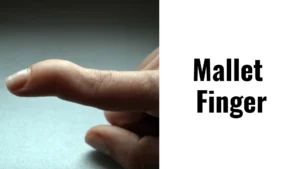Introduction
Mallet finger, also known as baseball finger or drop finger, is a common injury that occurs when the tendon that straightens the finger (the extensor tendon) is damaged. This injury often happens during sports activities, especially when catching a ball. Mallet finger can cause pain, swelling, and a drooping finger tip, making it difficult to fully extend the affected finger. It is important to understand the symptoms, causes, and available treatments for mallet finger, as well as how to prevent it from happening in the first place.

Overview
Mallet finger occurs when there is a forceful impact on the tip of a straightened finger, causing the extensor tendon to tear or become damaged. This injury can happen during various activities, such as catching a ball, when the ball hits the fingertip, forcing it to bend suddenly. When the extensor tendon is damaged, it is unable to properly straighten the finger, resulting in a drooping fingertip. Mallet finger usually affects the index, middle, or ring finger, but can occur on any finger.
Symptoms and Causes
The main symptom of mallet finger is a drooping fingertip that cannot be lifted or straightened without using the other hand. Other accompanying symptoms include pain, swelling, and tenderness around the injured finger. The most common cause of mallet finger is a traumatic event, such as a blow to the fingertip. This can occur when playing sports, during an accident, or even while performing everyday tasks. It is important to seek immediate medical attention if any of these symptoms occur, as permanent deformity or chronic pain can result if left untreated.
Diagnosis and Tests
To diagnose mallet finger, a healthcare professional will examine the injured finger and assess its range of motion. X-rays may be ordered to determine the extent of the injury and rule out any fractures. In some cases, additional imaging tests, such as magnetic resonance imaging (MRI), may be recommended to further evaluate the injury. These tests help healthcare professionals determine the severity of the mallet finger, which guides the appropriate treatment approach. It is crucial to seek medical attention promptly for an accurate diagnosis and timely treatment.
Management and Treatment
Treating mallet finger often involves splinting or immobilizing the affected finger. This allows the torn tendon to heal and reattach to the bone. A splint, typically made of plastic or metal, is applied to keep the fingertip in an extended position. It is essential to wear the splint consistently for the prescribed amount of time, which may range from a few weeks to several months depending on the severity of the injury. In some cases, surgery may be required if the injury is more severe or if nonsurgical treatment fails to produce desired results. Rehabilitation exercises and physical therapy may also be recommended to restore finger function and strength.
Prevention
While accidents happen, there are measures that can be taken to help prevent mallet finger. These include wearing protective gear, such as gloves or splints, during sports or activities that have a higher risk of finger injuries. Strengthening the muscles and tendons in the hand and finger through regular exercises can also help reduce the risk of mallet finger. Additionally, practicing proper technique and using caution when handling objects that could potentially impact the fingers can minimize the likelihood of this injury occurring.
Outlook / Prognosis
The outlook for mallet finger is generally positive with prompt and appropriate treatment. In most cases, with proper splinting and immobilization, the extensor tendon will heal within a few weeks to a few months. Once the splint is removed, it is common for some stiffness and swelling to persist, but these usually resolve with time and rehabilitation exercises. It is important to follow the recommended treatment plan and attend follow-up appointments to ensure optimal recovery and prevent complications.
Frequently Asked Questions
-
- Q: Can mallet finger be treated without surgery?
A: Yes, mallet finger can often be successfully treated without surgery by wearing a splint for an extended period of time to allow the tendon to heal.
-
- Q: Can mallet finger lead to long-term complications?
A: Without proper treatment, mallet finger can result in permanent deformity, chronic pain, or limited finger functionality. Therefore, seeking medical attention promptly is essential.
-
- Q: Can mallet finger occur on any finger?
A: While mallet finger most commonly affects the index, middle, or ring finger, it can happen on any finger that experiences a forceful impact on the fingertip.
-
- Q: Can mallet finger occur in children?
A: Yes, mallet finger can occur in individuals of all ages, including children. It is crucial to seek medical attention for proper diagnosis and treatment.
Conclusion
Mallet finger is a common finger injury that can occur due to a traumatic event, particularly during sports activities. Prompt diagnosis and appropriate treatment are crucial to ensure optimal recovery and prevent long-term complications. By understanding the symptoms, causes, and treatment options for mallet finger, individuals can take necessary precautions to prevent this injury. It is important to seek medical attention if mallet finger is suspected, as early intervention can significantly improve the prognosis and restore finger functionality.